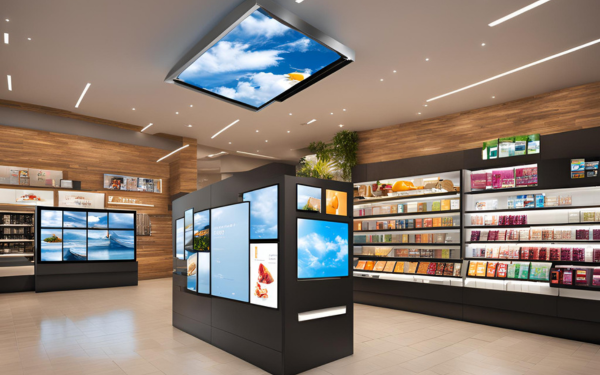Digital signage has come a long way in retail. From the early days of showing slide shows of static advertisements and promotions on rotation to playing TV feeds simply to add to the ‘ambience’ of the store, the variety and flexibility of how digital displays are used these days is barely recognisable.
Over the past few years, the biggest trend in digital signage has been retail media. Large retailers in particular have long found supplementary income in hosting and displaying brand promotions and advertisements in their stores. This became even more lucrative when online retailers like Amazon established their own advertising networks to control ad spend on their websites.
Since then, the trend has come full circle, with giant chains like Walmart and Tesco taking advantage of digital signage to sell lucrative advertising packages in store. This has allowed the online display advertising model to flourish on retail premises.
Now close to being a billion-dollar industry in its own right, in-store retail media wouldn’t be possible without digital signage. But that success only seems to have spurred on further innovation and creative thinking in how digital signage can be used to the benefit of both retailers and consumers. So what are the latest trends we’re seeing?
Convenience, inspiration, entertainment
Despite the success of retail media, most retailers these days understand that modern consumers have only limited patience with being bombarded with hard-sell messages (unless they happen to be well-targeted and personalised, which we will come on to). What shoppers are much more interested in than being told what to buy is an enjoyable experience.
What makes a shopping experience enjoyable? When asked, consumers tend to focus on three things – convenience, inspiration and entertainment. Two-thirds of shoppers say they want to be inspired by the brands and retailers they buy from. A quarter take that even further and say they want to be actively entertained to make shopping a pleasurable experience. But at the same time, people don’t want to be held up unnecessarily. 63% of consumers want to get from inspiration to purchase as quickly as possible, highlighting the importance of making the shopping experience convenient and streamlined.
Digital signage can be used to address all three areas. For convenience, signage has long been a useful tool for things like wayfinding in larger stores. With touchscreen technology making digital signage interactive, that is taken to a whole new level. Customers can look up the location of specific items at any point in the store. And beyond wayfinding, interactive digital displays allow customers to look up prices, product information, reviews and more.
As well as helping smooth the path towards customers finding the products and the information they want, there is an intrinsic element of entertainment to this. People like to be informed, and they like having the power to find the exact information they are looking for themselves, quickly and easily.
Furthermore, cutting-edge technologies like Augmented Reality (AR), the Internet of Things (IoT) and Artificial Intelligence (AI) can help supercharge the ability of digital signage to provide inspiration and entertainment as well as convenience. For example, fashion retailers have started pairing digital screens with cameras and AR software to create ‘magic mirrors’ or ‘virtual changing rooms’, allowing customers to see a digital image of themselves dressed in items of their choosing. It makes the ‘trying on’ process both easier and more fun. And the ability to try on many more items than you would normally be able to means more opportunities to inspire a purchase.
Coming back to personalization, the combination of IoT and AI can be used to personalize what customers see on a digital display automatically, without them having to instigate by using a touchscreen to look something up, for example. Sensor arrays or cameras can identify what items individual customers are browsing, and AI software can use this information to choose personalised content to display. This has obvious advantages for choosing carefully targeted advertisements and promotions that are more likely to strike a chord.
Other possibilities include pairing digital signage with biometric systems like facial recognition technology, and using displays to do things like administer loyalty schemes and serve as ‘personal virtual shopping assistants’ – greeting customers, asking for feedback about previous visits and purchases, making targeted recommendations and reminding them about rewards etc.
The key takeaway from all of this is that digital signage has a key role to play in customer communication going forward. Paired with other technologies, signage can become much more than a medium for one-way messaging from business to customer. It can provide a valuable source of interactive engagement, helping customers shape their shopping experiences according to their own preferences.




